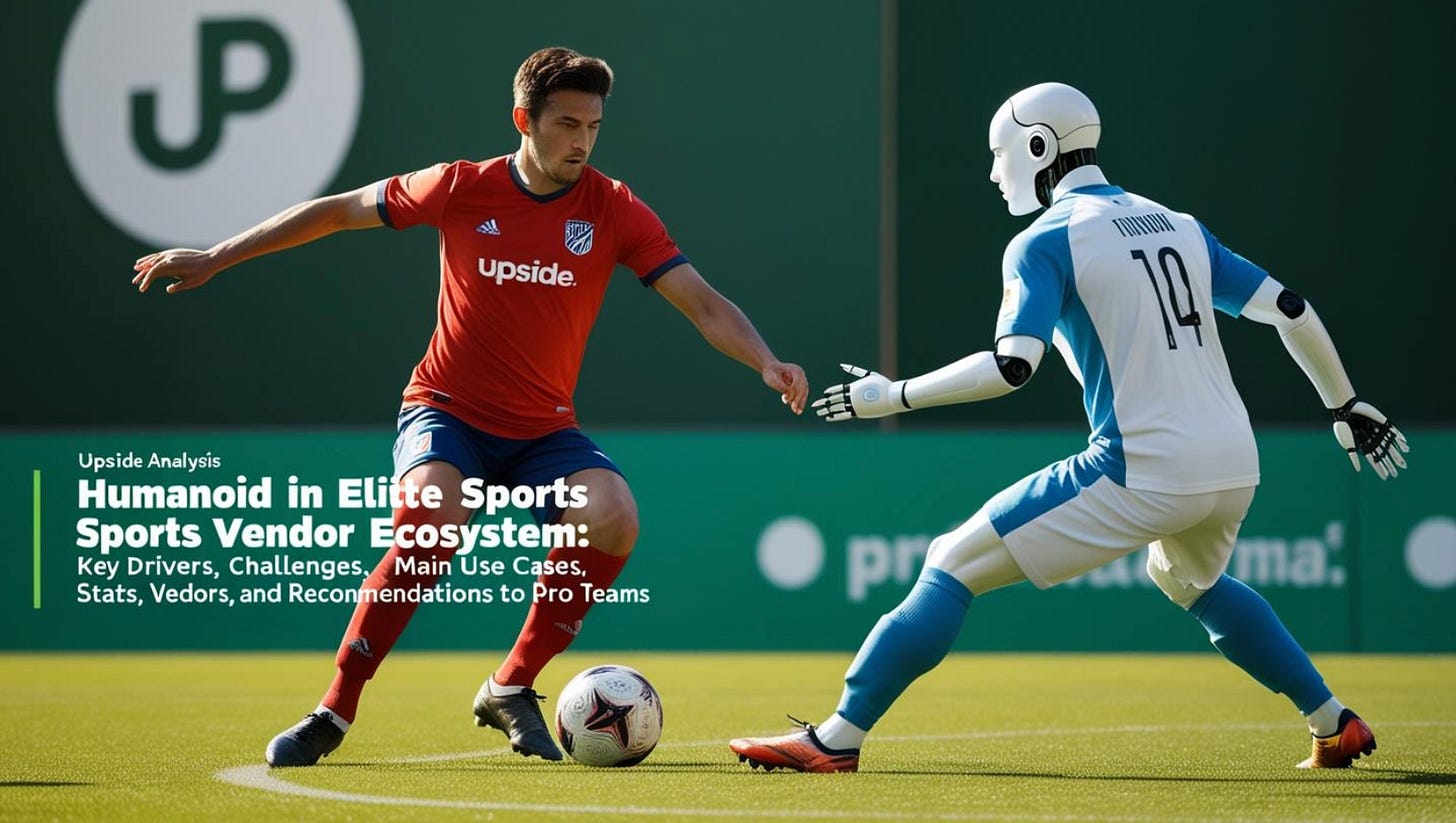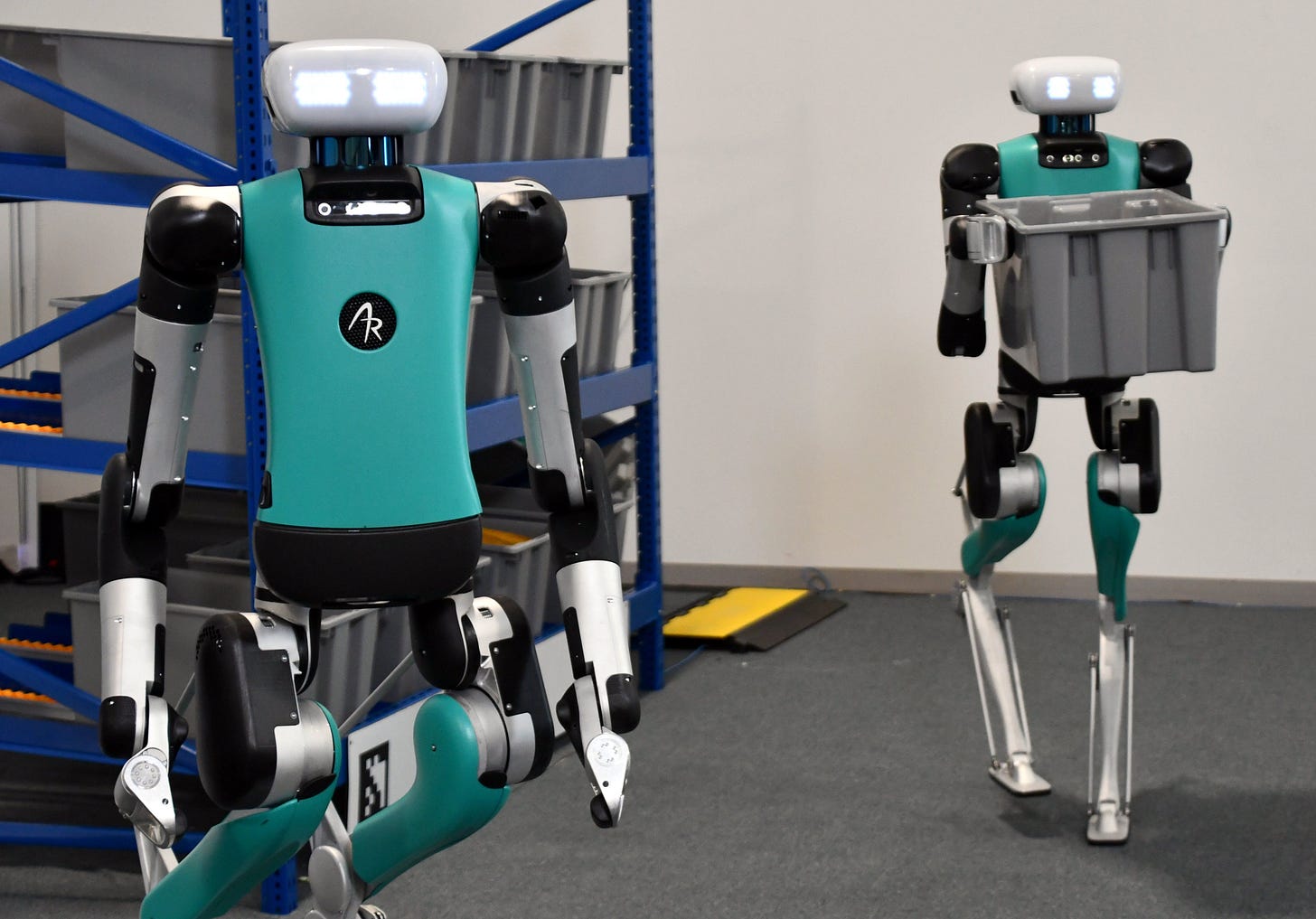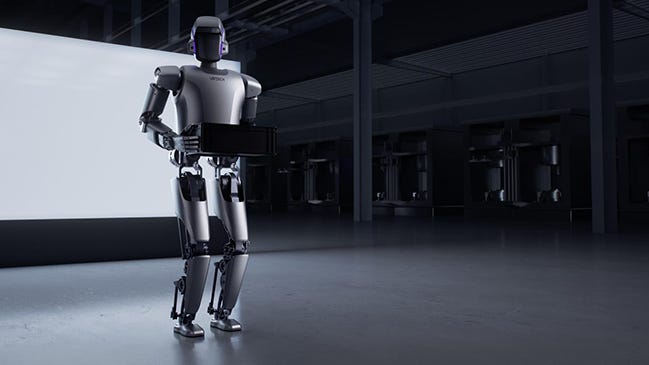🤖 Upside Analysis: Humanoids in Elite Sports Vendor Ecosystem: Key Drivers, Challenges, Future Use cases, Vendors and Recommendations to Pro Teams
The integration of humanoid robotics into elite sports is set to revolutionize training, rehabilitation, and fan engagement. As artificial intelligence (AI) and robotics technology continue to advance, professional teams are exploring innovative ways to enhance player performance, optimize recovery, and create immersive fan experiences. This report provides an in-depth analysis of the humanoid robotics vendor ecosystem in elite sports, covering market size, key drivers and challenges, primary use cases, adoption trends, major vendors, and recommendations for pro teams.
1. Market Size
The humanoid robotics market in elite sports is an emerging segment within the broader sports technology and robotics industry. The global humanoid robotics market is expected to grow from $1.8 billion in 2023 to over $6 billion by 2030, with a CAGR of around 19%. In elite sports, humanoid adoption is still in its infancy, but with increasing demand for AI-driven training and rehabilitation, the market could reach an estimated $500 million by 2027. The growing investment in sports technology, particularly in AI-driven automation and machine learning, is expected to accelerate this adoption.
2. Key Drivers
Advancements in AI & Robotics: Continuous improvements in AI, machine learning, and robotics are making humanoids more capable of mimicking human movements and responding dynamically. Enhanced deep-learning algorithms allow humanoid robots to analyze biomechanics in real time and provide immediate feedback.
Demand for Injury Prevention & Rehabilitation: Humanoid robots could offer in the long run precise biomechanical assessments and could aid in rehabilitation, reducing athlete downtime. The ability to provide controlled and repetitive movement training could make them highly effective in rehabilitation centers.
Labor Shortages & Cost Efficiency: With staff shortages in high-performance coaching and physiotherapy, humanoids could provide an alternative for repetitive training and monitoring long term. Teams looking to optimize their coaching resources could benefit from humanoid-assisted training sessions in the future.
Data-Driven Performance Optimization: These robots generate data that could help teams optimize player performance with greater accuracy. AI-powered humanoids could possibly measure fatigue levels, movement efficiency, and overall workload, assisting coaches in making informed decisions.
Enhanced Fan Engagement: Humanoids could also also be used in marketing and fan engagement strategies, creating unique experiences for audiences. These robots could interact with fans in stadiums, host pre-game activities, and serve as digital ambassadors for teams and leagues.
3. Key Challenges
High Cost of Implementation: In the long run, the cost of humanoid robots will range from $20,000 to $250,000, making it a significant investment for teams. Additionally, maintenance and software updates contribute to ongoing expenses.
Limited Adoption & Resistance to Change: Many teams still rely on traditional training methods, and adoption of humanoid robotics requires a cultural shift. Coaches and athletes may need training to effectively integrate humanoid assistants into their routines.
Technical & Ethical Concerns: AI-driven humanoids raise concerns regarding data privacy, long-term reliability, and ethical implications in sports. There is also the question of whether AI-driven training could create an unfair advantage in competition.
Regulatory & Compliance Barriers: Use of robotics in sports may require new regulations to ensure fairness and safety. Some governing bodies may impose restrictions on humanoid-assisted training or data collection.
4. Future Main Use Cases
Training Partner for Athletes: AI-driven humanoids may be able to mimic opponents, helping athletes train against realistic scenarios in the long run. They could potentially be able to simulate defensive movements in basketball, goalkeeping techniques in soccer, or sparring sessions in combat sports.
Biomechanical Analysis & Movement Correction: Robots could potentially be able to assess motion patterns and provide feedback to prevent injuries. By analyzing running form, acceleration, and balance, humanoids could help athletes optimize their performance while reducing injury risks.
Rehabilitation & Recovery: Humanoids could be able to assist in post-injury rehabilitation by guiding athletes through exercises in the future. Some robots could be designed to support patients recovering from ACL injuries or muscle tears by ensuring precise execution of prescribed movements.
Fan Interaction & Entertainment: Teams could be able to use humanoid robots for engaging with fans in stadiums and digital content creation. They could be able to serve as hosts, commentators, or even interactive mascots.
Refereeing & Officiating Support: AI-powered humanoids could be able to assist in officiating games with precise decision-making. While not yet widespread, AI-assisted refereeing could become more common in sports with fast-paced action like soccer and hockey.
5. Key Vendors
Source: Upside Global, Vendors’ pricing, 2025
Vendor Descriptions
Figure (Figure 01): Figure is developing a general-purpose humanoid with applications in sports rehabilitation, strength training analysis, and athlete workload management. Its AI-driven adaptability makes it a promising option for high-performance teams. Figure 01 robot units are likely run from $30,000 to $150,000 each for now.
Video: Future’s Helix humanoid robots.
Tesla (Optimus): Tesla's humanoid robot, Optimus, is designed for industrial and service applications but has potential uses in sports training and automation. Its AI capabilities may assist in repetitive movement training and fatigue analysis. Telsa is looking to offer Optimus for $20,000-$30,000 at scale in the long run.
Video: Tesla Optimus humanoid robot
Boston Dynamics: Known for its advanced humanoid robot, Atlas, Boston Dynamics specializes in high-mobility robotics that can be used for agility training and biomechanics assessments. Its robots excel in movement replication, and could help athletes refine techniques with real-time feedback. Industry analyses suggest that advanced humanoid robots like Atlas would likely be priced within the range of $150,000 to $200,000 or more, considering their sophisticated capabilities and the costs associated with their development.
Picture/video: Boston dynamics’ humanoid (Atlas)
Agility Robotics (Digit): Digit is a versatile humanoid designed for dynamic movement and load handling. In sports, it could be used for rehabilitation exercises, player logistics, and mobility training, making it a valuable addition to high-performance programs. Digit was introduced in 2023 with a price tag of $250,000. Agility Robotics implemented a RaaS model, aiming for a return on investment (ROI) in under two years compared to a fully loaded human labor cost of $30 per hour.
Picture/video: Agility Robotics’ (Digit) humanoid
Ubtech Robotics: With a focus on AI-enhanced humanoid solutions, Ubtech’s robots could help offer interactive training support, helping athletes develop cognitive skills while also being used for fan engagement activities in stadiums and digital spaces. The price of UBTECH Humanoid Robot Walker S is not publicly available.
Picture/Video: Ubtech Robotics Humanoid Robot Walker S
SoftBank Robotics (Pepper & NAO): These humanoids could be used for cognitive training, rehabilitation support, and fan interaction. While not primarily designed for high-performance sports, their AI capabilities could contribute to psychological conditioning and engagement strategies. The Pepper robot is available for approximately $32,000. The NAO V6 Standard Edition is widely used in research and education. While specific pricing isn't publicly listed, interested buyers are encouraged to contact the vendor directly for a quote.
Video: Softbank’s Pepper humanoid robot
Video: Softbank’s Pepper humanoid robot
Engineered Arts (Ameca): Ameca is one of the most advanced humanoids in terms of AI-human interaction. In sports, it could be used for media appearances, engagement, and marketing, helping teams enhance their brand presence. Reports suggest that Ameca units are priced north of $100,000, with some sources indicating figures around $250,000.
video: Engineered Arts (Ameca)’s humanoid robots
6. Key Recommendations to Pro Teams
Start with Pilot Programs: Invest in small-scale pilots with humanoids for training, rehab, or engagement before full adoption.
Leverage AI for Data Insights: Integrate humanoid robots with performance tracking systems to enhance decision-making.
Focus on High-Value Use Cases: Prioritize applications like injury prevention and biomechanical assessment for maximum ROI.
Collaborate with Robotics Vendors: Work closely with robotics companies to customize solutions tailored to team needs.
Educate Athletes & Staff: Provide training to ensure seamless integration and acceptance of humanoid technology in daily operations.
Conclusion
The humanoid robotics ecosystem in elite sports is poised for significant growth, driven by AI advancements and the need for precision training tools. While adoption is currently limited, strategic investments and targeted use cases will help teams unlock the full potential of humanoids in sports performance, rehabilitation, and engagement. In the future, we expect a growing number of teams to start adopting humanoids for specific tasks as part of their program but it will take some time before we see mass adoption in elite sports. The price of the humanoids will need to come down over time in order to see mass adoption in elite sports.
You may also like:
🦾 Upside Analysis: The Robotic Massage Landscape: Key trends, drivers, challenges, vendors, and recommendations to pro teams.
Robotic Massage Landscape Analysis
🔥Upside Chat with Alexi Pianosi (NHL), Dr Bill Burgos (NBA), Pierre Barrieu (MLS/EPL), Adam Quigley (MLS) on Wearables Adoption, ChatGPT/AI tools, Robotics & Stability in Pro Sports.
This week we had the honor to interview again a group of sports performance experts.







